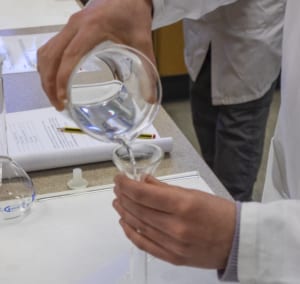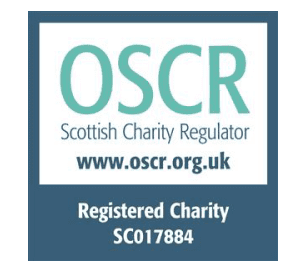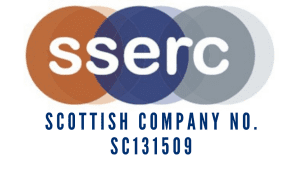
Photo by C Lloyd at SSERC (Public Domain)
Welcome to the National 5 chemistry page.
We have made a start uploading resources for experimental work that could help to support teaching of the course.
The resources are accessed from the section pages which you can get to from the links below.
Alternatively you can use the search facility or you can find a list of all the resources here.
The key areas covered in this section are:
a. rates of reaction
Colourless orange or blue (Demo) – a demo version of the Briggs-rauscher reaction as used in the antioxidants workshop.
Cool experiment (Demo) – endothermic reaction between barium hydroxide and ammonium thiocyanate.
Light sticks (Demo) – Effect of temperature on luminosity of glow-sticks (this can also be done as a class experiment)
Pyrophoric Iron – nanoparticles of iron are generated and when poured from a height they spontaneously catch fire in the air leading to a shower of tiny sparks.
Rhubarb, Rhubarb – Using rhubarb to decolourise permanganate in order to follow the rate of reaction, looking at concentration and surface area (and possibly temperature)
Antioxidants – This is a range of investigations based around the Briggs-Rauscher oscillating reaction to look at antioxidant levels in fruits and teas (though the method can be adapted for any source of antioxidants).
Bleaching Blue Food Dye – Reaction to determine rate constant and order of reaction from the bleaching of blue food colouring by domestic bleach. (Workshop is aimed at Advance Higher but without the mathematics it can easily be adapted to this level).
Thiosulphate acid reaction – microscale – A small scale version of the classic investigation into rates of reaction. Use of small scale and a neutralising bath reduces the production of toxic SO2
Catalysts
An autocatalytic reaction – A few drops of acid initiate a reaction which proceeds down a measuring cylinder changing colour as it goes – catalysed by its own products.
Catalyst at Work – A demonstration of a temporary activated complex of cobalt as it acts as a catalyst.
b. atomic structure and bonding related to properties of materials
(i) Periodic Table and atoms
(ii)Covalent bonding
Microscale Hoffman voltameter – Using a microscale Hoffman voltameter, made using syringes, to electrolyse water and then ignite bubbles of mixtures of hydrogen and oxygen.
Microscale Conductivity – Using a DIY conductivity meter to investigates conductivity of solutions.
(iii) Ionic bonding
Aluminium – Iodine reaction – (d) Solid iodine and aluminium powders are mixed and a few drops of hot water added. This initiates a reaction to form aluminium iodide, producing clouds of purple iodine vapour in the process.
Microscale Electrolysis of lead bromide – A microscale version of the classic experiment to show that a molten ionic solid will conduct electricity. The small scale means it can be done in the open lab.
Microscale Iron-sulphur – A small-scale reaction of iron and sulphur followed by investigation of the sulphide. The small scale approach means it does not need to be carried out in a fume cupboard.
Pyrophoric Iron – nanoparticles of iron are generated and when poured from a height they spontaneously catch fire in the air leading to a shower of tiny sparks.
Sodium burning in Chlorine and Oxygen – Guidance on a demonstration of how (relatively) hard it can be to set fire to sodium, followed by its vigorous reaction with chlorine.
c. formulae and reaction quantities
(i) Chemical formulae
Formula of magnesium oxide – microscale – a small scale version of this classic reaction to determine the formula of magnesium oxide.
Water in a hydrated salt – microscale – a small-scale experiment to determine the stoichiometric amount of water in some hydrated salts.
(ii) Calculations involving the mole and balanced equations
(iii) percentage composition
d. acids and bases
(i) pH
Dry ice in indicator solution – Dry ice is dropped into a flask of universal indicator. Clouds of dense ‘smoke’ come off and the indicator changes colour.
Colourful flowers (Demo) – Make paper ‘flowers’ soaked in different buffer solutions. Then spray indicator on and you get different colour flowers.
(ii) neutralisation reactions
Rainbow reaction – Form a rainbow of colours to illustrate the pH scale with HCl and sodium carbonate in a measuring cylinder or a test tube.
Indicators – microscale – A look at pH and indicators and how to make universal indicator
Neutralisation Circles – A simple, colourful experiment to show how pH varies across a gradient between acid and alkali.
Conductivity – Activity using a (home made) conductivity flask to follow neutralisation reactions.
Conductivity – microscale – a microscale investigation into the conductivity of solutions.
Titration – microscale – a microscale version of a titration that does not require burettes. This particular experiment is investigating the acidity of vinegars.
Vinegar Cheats – a larger scale investigation into the possible watering down of vinegar in the school canteen.
(iii) Neutralisation reactions can be used to prepare soluble salts
The key areas covered in this section are:
a. homologous series
(i) systematic carbon chemistry
(ii) alkanes
Microscale Cracking – The small-scale cracking of paraffin oil to produce a mixture of smaller alkanes.
(iii) cycloalkanes
(iv) alkenes
Dehydrating alcohols – A very similar reaction to the cracking one above but this time alcohols are dehydrated (using the same method) to give alkenes
b. everyday consumer products
(i) alcohols
Biodiesel: A workshop based around the production and testing of Biodiesel (fatty acid ethy esters) from vegetable oil
Determination of alcohol content – The method discribed, using density, is actually one used in the Alcohol exemplar for the Researching Chemistry section of the New Higher. Follow the link for details.
Ethanol Rocket – Similar to the whoosh bottle. A 2l drinks bottle is propelled across a room along a wire. The method allows calculations to be done relating to the energy changes.
Whoosh bottle (Demo) – Ignition of alcohol vapour in a 15l water bottle to produce a spectacular ‘whoosh’.
Non-Burning £5 Note – A demonstration of temperature and burning. NB Do not try this with new polymer notes!
(ii) Carboxylic acids
Vinegar Cheats – an investigation into the possible watering-down of vinegar in the school canteen.
Titration – microscale – A microscale experiment, similar to the above, looking at the concentration of acid in different vinegars.
c. energy from fuels
Dynamite soap (Demo) – Exploding hydrogen/oxygen bubbles generated by the elextrolysis of water.
Piezo rockets (Demo) – making and firing mini pipette rockets for hydrogen (or perhaps another flammable gas).
Whoosh bottle (Demo) – Ignition of alcohol vapour in a 15l water bottle to produce a spectacular ‘whoosh’.
Ethanol Rocket – Similar to the whoosh bottle. A 2l drinks bottle is propelled across a room along a wire. The method allows calculations to be done relating to the energy changes.
Biodiesel– A workshop based around the production and testing of Biodiesel (fatty acid ethy esters) from vegetable oil. Including energy values.
Non-Burning £5 Note – A demonstration of temperature and burning. NB Do not try this with a modern, polymer note!
When a Fossil Fuel is Burned – classic demonstration of the products of burning fossil fuels
The key areas covered in this section are:
a. metals
(i) metallic bonding
(ii) Reactions of metals… with oxygen
Microscale Formula of magnesium oxide – Using a bottle-top crucible to carry out the oxidation of magnesium ribbon and re-weighing to determine the formula.
Pyrophoric Iron – a demonstration where nanoparticles of iron are generated and when poured from a height they spontaneously catch fire in the air leading to a shower of tiny sparks.
Real reactivity of aluminium – a demonstration where mercury II chloride solution is used to remove the oxide coating from aluminium foil allowing it to react spontaneously with the air.
Sodium burning in Chlorine and Oxygen – Guidance on a demonstration of how (relatively) hard it can be to set fire to sodium, followed by it’s vigorous reaction with chlorine.
Salt and Battery – Use of fruit juices and different metal electrodes to investigate electrochemical cells.
… with water
Sodium (and other alkali metals) in water – Guidance on the safe way to carry out this classic chemistry demonstration.
… in the reactivity series.
Copper Etching – Activity using the displacement reaction between copper sulphate solution and zinc plate to etch a design.
Northern Lights – Demonstration showing the reactivity of aluminium: with acid and displacement with copper II chloride.
Thermit – A spectacular displacement reaction that produces molten iron – this version can be done in the classroom.
(iii) redox
(iv) extraction of metals
Rocks to Riches – Extraction of copper from ‘ore’ by leaching and electrowinning and analysis of copper content.
Electrolysis of lead bromide – A microscale version of the classic experiment to show that a molten ionic solid will conduct electricity. The small scale means it can be done in the open lab.
(v) electrochemical cells
Microscale Electrode potentials – A small-scale, convenient method of investigation electrode potentials of metal pairs using overlapping strips of filter paper.
b. plastics
(i) Addition polymerisation
Gloopy and gooey (Demo) – two experiments: Gaviscon in copper sulphate and PVA/Borax, both cross-linking polymers cross-linking polymers
Plastic Fantastic – Synthesis and testing of an electrically conductive plastic – polypyrrole
Latex cross-linking – Some simple reactions involving the cross-linking of latex solution to form rubber balls, rubber bands and foam rubber.
ii) Representation of the structure of monomers and polymers
c. fertilisers
(i) Commercial production of fertilisers
Ammonia fountain – Demonstration where a flask full of ammonia gas has a jet through a bung, the other end is submerged in water with aqn indicator. the introduction of a small amount of water lets some ammonia dissolve in it, reducing the pressure and producing a fountain as the water drawn into the flask.
(ii) Haber and Ostwald processes
d. Nuclear chemistry
(i) Radiation
(ii) Nuclear equations
(iii) Half-life
(iv) Use of radioactive isotopes
e. chemical analysis —learners are expected to be familiar with certain equipment and procedures.
(i) Common chemical apparatus
ii) General practical techniques
iii) Analytical methods
Instructions on how to use different apparatus and carry out various chemical procedures can be found here Chemistry Skills.
Some specific activities mentioned in the course can be found below.
Flame Colours – Some different methods of getting good colours for flame tests.
Water analysis – a series of different experiments for the analysis of various ions in water.
Diffusing precipitates – Some simple, drop-scale experiments looking at the formation of precipitates as ions diffuse.
Electrolysis of lead bromide – A microscale version of the classic experiment to show that a molten ionic solid will conduct electricity. The small scale means it can be done in the open lab.
Microscale Titration – A microscale version of a titration using a pasteur pipettes as a burette. The reaction can be followed either by counting the drops or by monitoring the change of mass on a balance.
Vinegar Cheats – Using a simple titration (with pipettes) to find out which samples of vinager have been watered down.
Vitamin C in Vegetables – Activity to determine the concentration of Vitamin C in fruit and vegetables by titration against DCPIP.
Conductivity – Activity using a (home made) conductivity flask to follow neutralisation reactions.
Microscale Conductivity – Using a DIY conductivity meter to investigates conductivity of solutions.
Drop electrolysis – A series of micro-scale investigations into the electrolysis of different solutions.
(iv) Reporting experimental work
Here you will find all the old Prescribed Practical Activities (PPAs) for Intermediate 1 and 2. They have all been updated with new layouts and with brand new risk assessments for each one.
Intermediate 1
Int 1 PPA1-1 – Effect of Temperature Changes on Dissolving Speed
Int 1 PPA1-2 – Effect of Concentration Changes on Reaction Speed
Int 1 PPA1-3 – Testing the pH of Solutions
Int 1 PPA2-1 – Electrical Conductivity
Int 1 PPA2-2 – Reactions of Metals with Acid
Int 1 PPA2-3 – Factors which affect Lathering
Int 1 PPA3-2 – Burning Carbohydrates
Int 1 PPA3-3 – Testing for Starch and Sugars in Food
Intermediate 2
Int 2 PPA1-1 – Effect of Concentration on Reaction Rate
Int 2 PPA1-2 – Effect of Temperature on Reaction Rate
Int 2 PPA2-1 – Testing for Unsaturation
Int 2 PPA2-3 – Hydrolysis of Starch
Int 2 PPA3-1 – Preparation of a Salt



